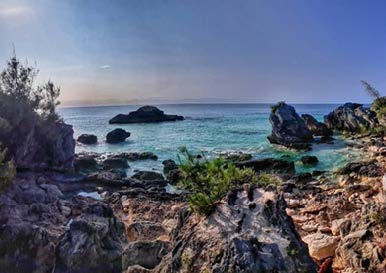INCREASED HURRICANE ACTIVITY HURTS BERMUDA’S OCEAN LIFE
By TIM SMITH
As we focus on the often striking damage to man-made infrastructure, destruction to the shoreline and ocean life can go unnoticed in the aftermath of a hurricane.
But the devastation to the natural world surrounding the island is now happening at such a pace that an environmental crisis is becoming harder and harder to ignore.
Matters will only get worse as an increasing number of hurricanes – blamed on global warming – wear away the coral reefs that have offered Bermuda protection against storms for centuries.
Hurricane Teddy, one of a record-breaking 30 named storms in the Atlantic last year, wiped out large sections of beaches including Warwick Long Bay.
Hannah Horsfield, the education coordinator at Bermuda Underwater Exploration Institute, said: “Every hurricane we lose more of our shoreline to the sea. Hurricane Teddy in 2020 caused serious beach erosion on the south shore of Bermuda.
“Although we have no footage of the damaged reefs, you can imagine how beaten the corals were by the storm surge. If it wasn’t for the protection of the coral reefs the loss would be far more devastating.”
Coral reefs, which serve as a natural barrier protecting coastal regions from storms and erosion, have suffered from bleaching events all over the world throughout the past 20 years.
Climate change, ocean acidification, overfishing, pollution and terrestrial runoff from human activities are among the factors that threaten them.
While no mass bleaching event has been recorded in Bermuda, fire coral can be seen bleaching in August, when the water temperature reaches its peak.
This means that the vibrantly coloured algae living on the outside of the coral are being expelled, leaving behind its vulnerable white skeleton.
If the stressful environment continues, the coral will not recover and die, as happened in the Caribbean during an extremely hot period in 2005.
Ms Horsfield said: “As sea temperatures are rising globally each year, the corals are in more danger of bleaching.”
She continued: “Any frequent diver or snorkeller will tell you that Bermuda’s reefs have undergone considerable degradation in the last decade.
“Fish are no longer plentiful and healthy coral reefs are disappearing. Black and white band disease is also frequent on Bermuda’s reefs.”
This year the Atlantic recorded its first hurricane on May 22: the seventh year in a row in which a major storm happened before the official start of the hurricane season on June 1.
“This is not a coincidence,” Ms Horsfield said.
“This is hard evidence that our climates are changing and for the worse. Bermuda is currently in a state of erosion as sea levels rise globally and hurricanes become more frequent.
“Our shoreline is disappearing at a much faster rate than in the centuries before.”
Methods that could stop the degradation include replacing diesel and gas cars with electric vehicles, using cleaner fuels such as natural gas instead of burning ancient crude oil, switching to renewable energy sources like solar and wind, banning single-use plastics and installing a marine trash skimmer to help clean the ocean.
Ms Horsfield said the public can help protect ocean life by following these tips:
Use reef safe sunscreen
Get a hunting licence for the invasive lionfish which feeds on juvenile fish and reproduces at an alarming rate
Help build seagrass cages to act as nursery grounds for fish, crustaceans and molluscs
Avoid pouring nasty chemicals down the toilet. They can seep through septic tanks, into the ground and then the ocean, damaging corals and marine life.

